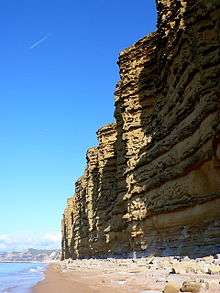Bridport Sand Formation
The Bridport Sand Formation is a formation of Toarcian (Early Jurassic) age found in the Worcester and Wessex Basins of central and southern England.[1][2] It forms one of the reservoir units in the Wytch Farm oilfield in Dorset.[3] The sandstone is very-fine grained to fine-grained and contains regular narrow bands that are calcite-cemented and more resistant to weathering, giving it a characteristic banded appearance at outcrop, such as in the cliffs between Bridport and Burton Bradstock in Dorset.[4] It is named for Bridport and has previously been known as the Midford Sand(s), Cotteswold Sands, Yeovil Sands and Upper Lias Sand(s).[1] It forms a locally important aquifer, particularly around Yeovil.[2]
| Bridport Sand Formation Stratigraphic range: Toarcian | |
|---|---|
 Cliffs of Bridport Sand between Bridport and Burton Bradstock | |
| Type | Geological formation |
| Unit of | Lias Group |
| Underlies | Inferior Oolite Group |
| Overlies | Beacon Limestone Formation or Whitby Mudstone Formation |
| Area | Wessex Basin, Worcester Basin |
| Thickness | Approx. 120 m |
| Location | |
| Country | England |
| Type section | |
| Named for | Bridport |
Extent and thickness
The Bridport Sand Formation is known from exposures in Dorset, Somerset and Gloucestershire and from the subsurface in numerous boreholes. It is also present offshore in the Portland–South Wight Basin, a sub-basin of the Wessex Basin.[5][6] It reaches a maximum thickness of over 135 m in the Kimmeridge-3 well, in the onshore part of the Portland–South Wight sub-basin. It thins northwards from Dorset onto the Mendips axis, where it is missing. It reappears to the north of the axis.[7]
Lithology
The formation shows significant lateral variations in lithology.[5][6] Three separate facies have been recognised; the Bridport Sands, the ferruginous (iron-rich) facies and the calcareous facies. The Bridport Sands facies consists of very-fine to fine-grained sandstones. They vary in colour from light grey to yellowish grey and contain varying amounts of silt and clay grade material. They are locally glauconitic and often calcareous. This facies is found in the main part of the Wessex Basin where the formation is at its thickest. The ferruginous facies consists of limestones cemented with goethite, ferroan calcite and dolomite. This facies is developed in the thinner sequence to the northeast of the Wessex Basin interbedded with the Bridport Sands facies. The calcareous facies consists of interbedded sandy limestones and very fine-grained sandstones, with some interbeds of calcareous claystones and siltstones. This facies is best developed to the east and south of the Portland–South Wight sub-basin.[6]
References
- "Bridport Sand Formation". BGS Lexicon of Named Rock Units. British Geological Survey. Retrieved 3 June 2016.
- "Baseline Report Series: 11. The Bridport Sands of Dorset and Somerset" (PDF). British Geological Survey. Retrieved 3 June 2016.
- Morris K.A. & Shepperd C.M. (1982). "The role of clay minerals in influencing porosity and permeability characteristics in the Bridport Sands of Wytch Farm, Dorset" (PDF). Clay Minerals. 17: 41–54.
- Kantorowicz J.D.; Bryant I.D. & Dawans J.M. (1987). "Controls on the geometry and distribution of carbonate cements in Jurassic sandstones: Bridport Sands, southern England and Viking Group, Troll Field, Norway". In Marshall J.D. (ed.). Diagenesis of Sedimentary Sequences. Special Publications. 36. Geological Society. pp. 103–118. ISBN 9780632019397.
- Hawkes P.W.; Fraser A.J. & Einchcomb C.C.G. (1998). "The tectono-stratigraphic development and exploration history of the Weald and Wessex basins, Southern England, UK". In Underhill J.R. (ed.). Development, Evolution and Petroleum Geology of the Wessex Basin. Special Publications. 133. London: Geological Society. pp. 39–65. ISBN 9781897799994.
- Ainsworth N.R.; Braham W.; Gregory J.; Johnson B.; King C. (1998). "The lithostratigraphy of the latest Triassic to earliest Cretaceous of the English Channel and its adjacent areas". In Underhill J.R. (ed.). Development, Evolution and Petroleum Geology of the Wessex Basin. Special Publications. 133. London: Geological Society. pp. 103–164. ISBN 9781897799994.
- Morris J.E.; Hampson G.J. & Johnson H.J. (2006). "A sequence stratigraphic model for an intensely bioturbated shallow-marine sandstone: the Bridport Sand Formation, Wessex Basin, UK". Sedimentology. 53 (6): 1229–1263. doi:10.1111/j.1365-3091.2006.00811.x.